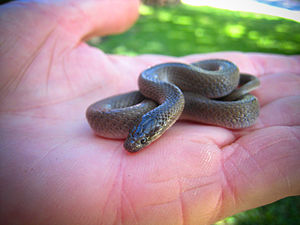- Virginia striatula
-
rough earth snake 
Scientific classification Kingdom: Animalia Phylum: Chordata Subphylum: Vertebrata Class: Reptilia Order: Squamata Suborder: Serpentes Family: Colubridae Subfamily: Natricinae Genus: Virginia Species: V. striatula Binomial name Virginia striatula
(Linnaeus, 1766)Synonyms Coluber striatulus
Linnaeus, 1766
Natrix striatulus -
Merrem, 1820
Haldea striatula -
Baird & Girard, 1853
Conocephalus striatulus -
Duméril & Bibron, 1854
Falconeria bengalensis
Theobald, 1868 (fide Bauer & Das, 1999)
Potamophis striatulus -
Garman, 1892The rough earth snake (Virginia striatula) is a species of nonvenomous natricine colubrid snake native to the southeastern United States. It was first described by Carolus Linnaeus in 1766, as Coluber striatulus.
Contents
Geographic range
It is found from Texas to Florida, and as far north as Missouri and Virginia.
Description
The rough earth snake is a small, brown, unpatterned snake with lightly keeled scales (which gives it its common name), and a light colored underside. They do not typically grow beyond 10 inches in length, with 7 inches being average. It is easily mistaken for the smooth earth snake, Virginia valeriae, with which it shares range and habitat. The keeled scales of V. striatula are the only way to visually distinguish the species from V. valeriae, which has smooth (non-keeled) scales.
Habitat
They are a fossorial species, spending most of their time buried in leaf litter, loose soil, or beneath rotting logs or other ground debris. It prefers habitats that are not prone to flooding.
Reproduction
They are ovoviviparous, with young being born in mid-summer. Brood size varies from 3 to 8. Newborns are about 10 cm (4 inches) in total length.
Behavior
Given their lack of sufficient defense mechanisms against larger animals, earth snakes are generally not aggressive towards humans and are harmless if encountered. While they do have teeth, the size of the mouth and teeth make any strikes against humans superficial at worst. They can defecate as a defense mechanism to make them less palatable to would-be predators. If necessary, they can be safely picked up by hand and relocated.
Diet
Their primary diet consists of earthworms and soft-bodied arthropods. Earth snakes eat a wide variety of suitably sized insects and other invertebrates, including snails and slugs, making them a gardener's friend.
References
- Species Virginia striatula at The Reptile Database
External links
Categories:- Colubrids
Wikimedia Foundation. 2010.

